 |
|
|||
 |
 |
|||
RINKER ON COLLECTIBLES — Column #1803 Copyright © Harry Rinker, LLC 2021 Questions
and Answers
QUESTION: I have 23 of the 24 Clair Bee Chip Hilton sports novels written for adolescent boys and published by Grosset & Dunlap between 1938 and 1966. The “Fiery Fullback,” the 24th book in the series, is the only title I am missing. All are first editions. Nine of the books have brown covers. The remaining 14 have color lithograph covers, albeit they are hardbound. The binding on “4th Down Showdown” is weak, but I can live with this. I am a 1970s relic and at a point where I need to decide what to do with the books. What do you suggest? – FP, Follansbee, WV, Email Question 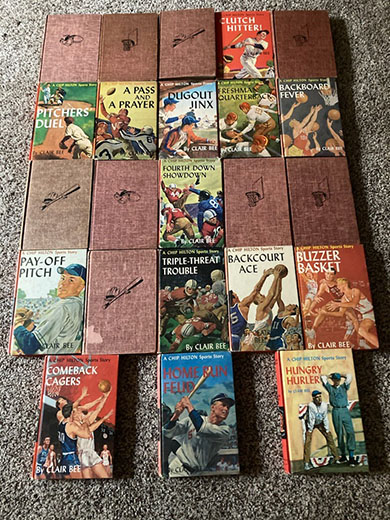
ANSWER: My first recommendation is to read them again, even if it is for the last time. Memories are more important than objects. Let your last memories be memorable ones. Clair Bee (1948 to 1966), a college basketball coach and 1968 Basketball Hall of Fame inductee, wrote the series. Bee died in 1966, essentially ending the series. A growing interest in television programming also was a factor. “Fiery Fullback,” his unpublished manuscript, was published by Grosset & Dunlap in 2002. The series sold over 2.2 million books. The first six books in the series were issued in fire-engine red, smooth textured bindings with blank outer covers. These six books also had full color dust jackets. The first six titles were reprinted. The reprints have blank rougher tweed cover binding and picture dust jackets. Issues #7 through #19 also had this rougher tweed cover binding and picture dust jackets. All 23 titles were re-issued in picture cover versions, the images copied from the hardcover editions. These were done later than the first edition dates of #1 to #24, although they appear to be first editions based on information found on the copyright page information. Paperback editions were issued. The first printing of the first 12 paperback books included a holographic image of a Chip Hilton logo. A Nashville religious book publisher re-issued the entire Chip Hinton series in the late 1990s. What this means is that you have only a few “true” first editions at best in your collection. The first six books must have the fire engine red, smooth cover with dust jacket and titles #7 and #19 the rougher tweed cover binding with dust jacket to have a “true” first edition. None of the books in your collection have dust jackets The picture cover versions are reprints. Of course, you may have a first printing (but not edition) of one or more of these titles. 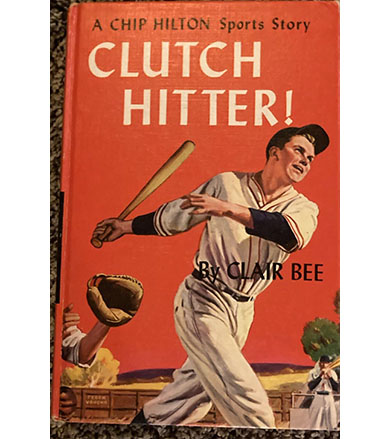
[Author’s Aside: As interest in the Chip Hilton series waned, Grosset & Dunlap printed fewer copies. As a result, a copy of “Hungry Hurler” (#23) with the rough cover and dust jacket is among the most desirable titles. Only 12,000 copies were printed.”] A WorthPoint Worthopedia “sale date” search reveals that an average price for a single title in very good condition with a color cover or a hardcover title missing its dust jacket ranges from $5.00 t0 $7.00 per volume. If the condition is very fine or better, a sell through price of $10.00 is often obtainable. Recent sales indicate that sellers prefer selling titles individually. Some charge excessive shipping charges to make their profit from the shipping overage rather than the books. The secondary market is flooded. This keeps prices low. There are 50 to 60 Chip Hilton books for sale on eBay at any given time. Do not look at asking prices. A seller can ask any price they want. If searching a title on eBay, make certain to use an advance search and ask for examples that have sold. Like so many objects on eBay, you will quickly realize there is a big difference between asking and getting prices. When it comes time to sell your set, I recommend offering the group as a lot. A good asking price would be $125.00, but be prepared to accept less. If you sell individual titles, buyers will buy the best examples, a process known as cherry picking a collection. Make the sale a winner-take-all. You do not want to be stuck with copies you cannot sell. QUESTION: My dad was born in 1925. At some point in his life, I am not certain when, he acquired a bronze elephant with an open woven basket hanging down each side. The piece measures 9 inches from nose to tail and is 6 inches high. It is 5 1/2 inches in maximum width. There are no maker’s marks on it. My dad used to put his watch on the trunk, his ring on the tail, his cuff links and extra rings on one side, and his billfold on the other. Have you seen anything like this? – TN, IA, Email Questiom 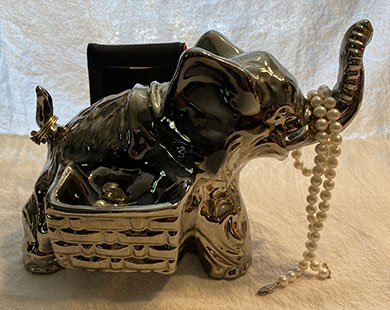
ANSWER: T\If your dad was born in 1925, he most likely received the elephant in the late 1940s or early 1950s. Bronze and other metallic plated, pot metal cast objects were extremely popular in the 1950s. There also was a mild elephant craze during the same period. The elephant jewelry holder is a little too good for a five and dime store item but certainly something that a buyer could find in a medium size department store or small-town specialized jewelry shop of the period. It most likely was made in post-war Japan but also could have been made in post-war Europe. A wholesale jobber who sold inexpensive merchandise to stores imported the elephant jewelry holder and similar items. I tried multiple searches on WorthPoint’s Worthopedia to see if I could find an exact match. I was not successful. I did find a pewter elephant with six elephant topped cocktail picks from the same period. It was marked “Spain.” Your elephant jewelry holder’s value is the personal memories it represents. Its secondary mark value is under $20.00. QUESTION: Thirty years ago my wife and I purchased a chair at an auction. I use it to sit at our dining room table. The arm chair has a caned back and seat. The seat is trapezoidal and has a maximum width of 23 inches (19 1/2 inches between the arms. The back stiles, arm supports, foot rest, and spreader are twisted. I found no markings on the chair. My wife has passed away, and I need to downsize. Does the chair have any value in today’s world? – KM, Oil City, PA, Email Questiom 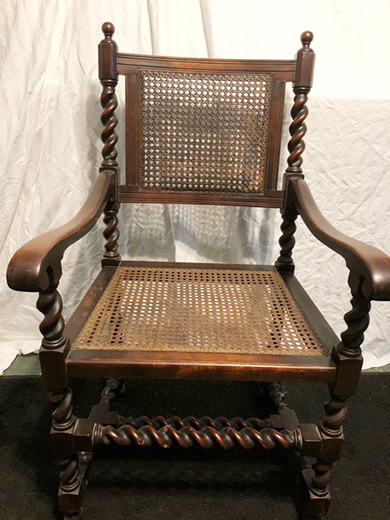
ANSWER: Your chair is a Colonial Revival chair from the 1920s or 1930s. Colonial Revival furniture mixed and blended high-style period furniture designs into new functional furniture. The twisted stiles, arm rests, foot rests, and spreaders are associated with the Victorian era Elizabethan Revival style. With a little imagination, the overall look of the chair is from the Chippendale period. The caned back and seat dates back to the Queen Anne period. The chair was once part of a set of four or six similar chairs. The four-piece set consisted of one arm chair and three side chairs. The six-piece set had two arm chairs and four side chairs. Your chair is an orphan. Its primary value is for reuse. A new owner will use it just as you do – to sit in it. Brown goods’, the trade name for your type of furniture, secondary market is flat. The furniture does not appeal to younger buyers. Any offer of $25.00 or more is fair. QUESTION: I have a metal statue of a nude child or pixie. I think it is a one-of-kind. Did Armor Bronze do one-of-a-kind castings for sculptors? I have seen one Armor Bronze statue attributed to a famous sculptor, but it was not signed by the sculptor. Any information you can provide would help. – SS, Email Question 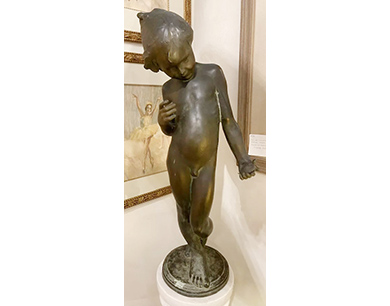
ANSWER: I am not certain your metal sculpture is a one-of-a-kind. The statue lacks the fine detail associated with artist castings. Your statue does not have an artist’s signature nor a foundry casting mark. Also, sculptors often ordered multiple castings of their work. Armor Bronze made mass-production products. Companies such as Armor Bronze did commission artists to make sculptures that could be cast and sold to the general public. These often lack the detail associated with high-end sculptural castings. Armor Bronze did mass-produce a series of sculpture figures such as Abraham Lincoln and knights in armor. All were under 12 inches. Could Armor Bronze do a one-of-a kind casting? Anything is possible, but I doubt it. Harry L. Rinker welcomes questions from readers about
collectibles, those mass-produced items from the twentieth and twenty-first centuries.
Selected letters will be answered in this column.
Harry cannot provide personal answers.
Photos and other material submitted cannot be
returned.
Send your questions to: Rinker on Collectibles, 5955 Mill
Point Court SE, Kentwood, MI 49512.
You also can e-mail your questions to
harrylrinker@aol.com.
Only e-mails containing a full name and mailing address
will be considered.
|
||||